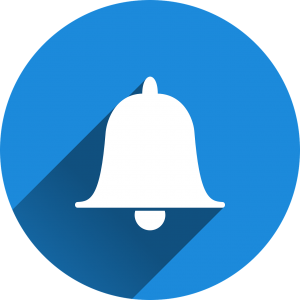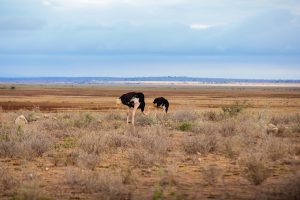Is there anything in your life that fills you with dread, or a sinking feeling of anxiety in the pit of your stomach? First dates? Going to the doctor? Surprise visits from your in-laws? How about something that comes around every month, like maybe your bills and financial statements? Just just looking at those words in black and white might be reminding you of the unopened stack (or emails) that you’ve been avoiding, and might be giving you that familiar sick feeling. So why do you do it? Why do you avoid dealing with your finances like the plague, when it’s clear that getting on top of them is a better plan of action? And what can you do to get over your anxiety and take charge of your financial life?
The Ostrich Effect
Psychologists actually have a name for that tendency to avoid information that you perceive as potentially unpleasant: the ostrich effect. The name comes from the common myth that ostriches bury their heads in the sand when they feel like they’re in danger. And while those birds don’t actually do that, we humans do have a tendency to ignore negative information at times of risk or danger, trusting that everything will go well without us taking any action.
This whole “head in the sand” thing might be exactly what you’re feeling like when it comes to your bills and financial statements – and you’re not alone. Many studies on the ostrich effect focus on how people handle financial information, including a famous one that found that investors tend to check on their portfolios more frequently when markets are performing well, but will “bury their heads in the sand” when markets are performing poorly. This is the case despite the fact that checking their portfolio could help these investors make more informed decisions.
Right – the fear we have of facing our finances is not rational, even though it’s very real. So real, in fact, that the American Psychological Association’s (APA) March 2022 Stress in America survey found that money stress registered at the highest level recorded since 2015. And while most people know that checking their bank account and dealing with their bills is necessary, doing so can cause stress and anxiety, because those figures are more than just numbers on a screen. They can represent how you feel about yourself, or bring up feelings of past childhood traumas or insecurities.
Sounds deep, right? Yup: psychologists have a lot to say on this subject, musing that financial avoidance is more than just “forgetting” to check your statements, or putting it off until a more convenient time. Here’s what a few have to say on the matter:
- “Because money touches so many aspects of our lives, we project a tremendous amount of personal meaning onto it,” says Amanda Clayman, LCSW, a financial therapist who has formed a cognitive behavioral therapy (CBT)–based program focused on financial wellness. “It can represent your fear of failure, one-upsmanship with a sibling, regret over a bad spending habit, or frustration with where you are in life.”
- According to Perpetua Neo, a psychologist who specializes in anxiety and frequently treats patients with financial anxiety, there’s typically a “story” attached to the stress surrounding our finances. It might be that you observed your parents getting distraught over bills or finances when you were a child, essentially normalizing that stress and making it something to avoid. Or maybe you experienced upheaval, like moving to a new place or switching schools, due to a parent’s job loss, meaning you associate finances with stress.
But she also points out that any trauma in our histories could trigger this kind of anxiety and tendency toward pessimism, as well as a desire to avoid those feelings: “When something bad has happened to us, our world of assumptions shatters and we start believing in the worst,” Neo says. “Our brains are wired to remember and be affected by loss.”
- Other experts point out that sometimes financial anxiety stems from big life changes, like switching jobs, moving to a new city, or having a child. You might know you need to adjust how you manage your money, but the thought of actually doing it can be overwhelming.
- You could also be overwhelming yourself, according to some therapists. You could be creating a vicious cycle of financial anxiety: you get behind, so you force yourself to do a super intense session of financial data review, bill paying, etc. You end up down a rabbit hole, and after hours and hours of looking at transactions and confusing data, you quit, exhausted, telling yourself that you were right to avoid the whole sordid affair all along.
Those are some of the possible why’s, but we also need to know what signs to look out for, and how you can make things better for your mental health and your bank account.
Signs You’re Hiding from Your Finances
So how do you know if you’re avoiding reality, and putting your head in the sand when it comes to your finances? Watch out for these signs:
- You try to put money and finances out of your mind
- You avoid talking about money with family and friends
- You hide things about your finances from your partner
- You avoid opening bank statements or credit card bills
- You don’t know what your credit score is
- You don’t know your net worth
- You feel ashamed that you’ve let your bank statements, credit card bills, etc pile up
- You feel caught in a cycle of self-blame
If any or all of the above sounds familiar, it’s time to get unstuck and move past the shame and self-blame, so you can take some concrete steps toward financial health. After all, if you continue to avoid dealing with your finances, you’ll most likely end up making more financial problems for yourself, and more anxiety, in the long run. The financial consequences of sticking your head in the sand could include:
- Making bad decisions – If you don’t know where you stand financially, you could be tempted to spend more than you should on unnecessary expenses, which could also lead to difficulty making payments for the things you do need. All of these less-than-ideal decisions could land you in debt.
- Allowing things to snowball – Continuing to spend while ignoring important information about your finances could cause any small financial problems to snowball into big debts.
- Failing to meet financial objectives – You can’t save, or even pay off debts, if you don’t even know the basics of your financial situation!
Not only that, but the APA also points out that, if you do end up in debt because of your problems dealing with your finances, you could be setting yourself up for more than just a hit to your wallet. “Debt is associated with lower self-esteem, lower productivity, and greater stress,” according to the APA. “Unsurprisingly, research has also linked financial strain to depression.”
But don’t despair! You’ve done enough catastrophizing…now it’s time to get on top of things!
How to Take Back Control
You can do this! You might feel like things are spiraling out of control, and you’ll never be able to take your hands away from your eyes and look at the real state of affairs, but there are steps you can take to get on top of things. And step one? Recognizing what that you’re hiding from your finances – you’ve come this far, so you’re on your way!
The strategies you can employ to reduce the ostrich effect when it comes to your finances include:
Start slowly
According to Clayman, “Any change—even good change—creates a certain amount of associated stress.” So if you’re finally looking at your finances for the first time in a while, the first thing you should do is simply gather information, not jump in and start trying to make changes immediately. You could end up overwhelmed again! So, for example, if you’re concerned about your budget, spend a month observing your spending patterns. Look at when you spend money, and what you’re buying. Figure out what your spending patterns are, and why you might be spending in that way. Once you’ve done this, you can hopefully start to find healthier ways to meet your emotional needs, other than overspending.
Once you’ve gotten past that first look (and realize you can do it), experts recommend that you figure out how much time per week you’re willing and able to spend dealing with your finances, and then be consistent about it. If 30 minutes per week sounds doable, start there, and ensure it becomes part of your routine. If that sounds overwhelming, start smaller: dedicate 15 minutes a week to banking, or perform one manageable-feeling task each day, like paying or even simply reading one bill. The more you accustom yourself to doing these little things – and sticking with them consistently – the more you’ll realize that it’s not so scary after all. Remember, you’ve got this!
Distance yourself
If you’re really having trouble taking that first peak, you can try what psychologists call “debiasing techniques.” This can include creating psychological distance from the problematic information, so you’re less likely to avoid it. For example, this could involve pretending that you’re looking up information so you can help a friend, rather than addressing your own issue.
Use technology

Try setting up scheduled emails or notifications that provide you with all your necessary information once a month, in a format that you’re likely to check. And don’t stop at getting your info automated: arrange to have a portion of your paycheck automatically deposited into your savings account and your retirement account, and set up automatic reminders to alert you when a bill is due. It’s a lot harder to make a bad decision when the decision is out of your hands! You can also use budgeting apps or other software to help you keep track of your finances in a simple, unintimidating way.
Have an accountability partner
Just as you can use technology as an “external mechanism” as psychologists say, you can also use someone who cares about you as an external mechanism. They can help to hold you accountable and make sure you’re dealing with the information that you need to deal with.
Make a plan B (and C)!
All the experts tell you to make a plan and a budget, and then stick to it. But Clayman recommends having not just a plan A, but also a plan B and C, so you don’t get too freaked out when making changes in your financial life. According to her, “When we feel trapped, and forced into a change, our brain goes into fight or flight mode, and it becomes much harder to manage our rebellious impulses.” If you give yourself multiple options, you’ll be more likely to feel in control, and less likely to stick your head in the sand.
Reward Yourself
You can also make dealing with your finances less stressful and scary by making doing so a more pleasant affair. Some experts suggest things like “money dates,” in which couples get together, work on their finances, and then spend some time together over dinner or with a bottle of wine. Or perhaps you can schedule getting your finances in order right before something more enjoyable, like a TV show you want to binge, or a night out with friends. “Rewards are an excellent way to reinforce progress and help [yourself] stay consistent,” Clayman says. “They don’t have to be extravagant or exotic. The most important aspect of the reward is that you truly enjoy it, and associate it with your effort.”
Hey, we get it: adulting is hard, and one of the hardest parts is dealing with your finances. But sticking your head in the sand and ignoring your statements and bills is not the way to stay on top of things! But neither is beating yourself up with blame and shame, so do yourself a favor: think about why you might be doing what you’re doing, and then slowly start to find a practice and a routine that allows you to take control of your financial life, and get yourself on the road to feeling some relief from your anxiety.







